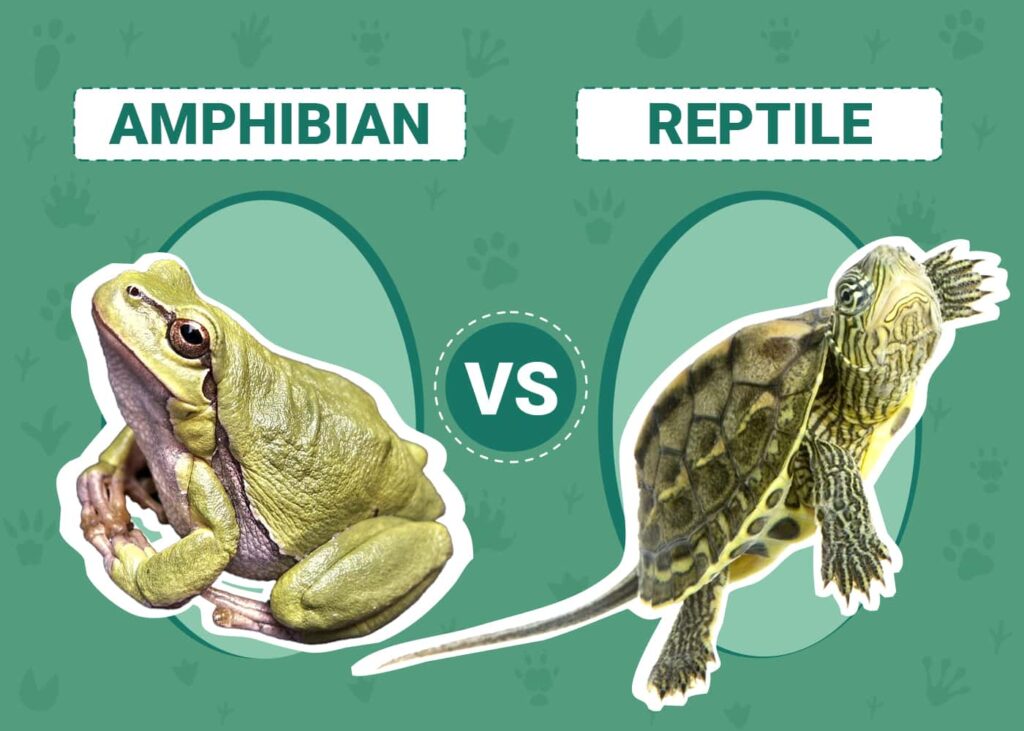Reptiles and amphibians are two distinct groups of cold-blooded vertebrates that often get confused due to their similar habitats and certain biological features. However, they have unique characteristics that set them apart. In this mega blog, we will explore their classifications, physical attributes, habitats, life cycles, and behaviors, giving you a comprehensive understanding of these fascinating groups.
Taxonomy: Classifications and Definitions
Reptiles
Reptiles belong to the class Reptilia. This class includes a wide variety of animals such as:
- Lizards
- Snakes
- Turtles
- Crocodilians
- Birds (considered reptiles due to evolutionary lineage)
Amphibians
Amphibians belong to the class Amphibia. This class is characterized by three primary groups:
- Frogs and Toads (Anura)
- Salamanders (Caudata)
- Caecilians (Gymnophiona)
Physical Characteristics
Skin Texture
- Reptiles: Have dry, scaly skin made of keratin, which prevents water loss and allows them to thrive in drier environments. The scales can vary widely in texture and coloration.
- Amphibians: Typically possess moist, smooth skin that is permeable to water. This skin allows them to absorb moisture and oxygen but also makes them more susceptible to dehydration.
Respiratory Systems
- Reptiles: Breathe through lungs throughout their life. They have a more advanced lung structure compared to amphibians, allowing for more efficient respiration.
- Amphibians: Generally have a dual respiratory system. They can breathe through their skin (cutaneous respiration) and use lungs as adults. Many larval amphibians, like tadpoles, breathe through gills.
Limbs and Movement
- Reptiles: Typically have four limbs (though snakes have evolved to lack limbs) and are adapted for various forms of locomotion, such as climbing, running, or swimming.
- Amphibians: Generally have four limbs and exhibit a range of movement styles. Many frogs are known for their powerful jumping abilities.
Reproduction
- Reptiles: Mostly reproduce via internal fertilization, laying eggs with hard shells (like those of turtles) or giving live birth (as in some snakes). Their eggs are more resilient to drying out, allowing for a variety of habitats.
- Amphibians: Usually undergo external fertilization, with eggs laid in water or moist environments. Their eggs are often gelatinous and vulnerable to drying out, leading to a strong dependence on aquatic habitats for reproduction.
Life Cycle Differences
Reptiles
- Life Cycle: Generally consists of eggs or live birth, followed by juvenile stages that resemble adults. Many reptiles don’t undergo significant transformation; they grow and mature without drastic changes.
Amphibians
- Life Cycle: Amphibians undergo a distinct metamorphosis. They typically start as aquatic larvae (like tadpoles) with gills, later transitioning to land-dwelling adults with lungs and limbs. This life cycle often involves significant changes in anatomy and habitat.
Habitat Preferences
Reptiles
- Habitat: Reptiles are adaptable and can be found in diverse environments, from deserts to forests and even aquatic habitats. Their scaly skin allows them to retain moisture, making them less reliant on water than amphibians.
Amphibians
- Habitat: Amphibians are typically found in or near water sources, as they require moist environments for breeding and skin respiration. They thrive in wetlands, ponds, and forests, where humidity levels are higher.
Behavior and Adaptations
Reptiles
- Behavior: Reptiles are often solitary and territorial. They may use basking behaviors to regulate their body temperature and are generally less social than amphibians.
- Adaptations: Many reptiles have developed various adaptations for survival, such as venom in snakes or camouflage in lizards.
Amphibians
- Behavior: Amphibians can exhibit more social behaviors, especially during mating seasons. They often communicate through calls and are known for their complex mating rituals.
- Adaptations: Amphibians have unique adaptations, such as poison glands in certain species (like poison dart frogs) and the ability to regenerate limbs in salamanders.
Conservation Status
Both reptiles and amphibians face significant conservation challenges due to habitat loss, pollution, climate change, and disease.
- Reptiles: Many species are threatened due to habitat destruction and illegal trade.
- Amphibians: Amphibians are among the most endangered groups of vertebrates. The chytrid fungus has devastated many populations worldwide.
Conclusion
While reptiles and amphibians share some similarities as cold-blooded vertebrates, they are fundamentally different in various aspects, including physical characteristics, life cycles, and habitats. Understanding these differences enriches our appreciation for the diversity of life on our planet and highlights the importance of conserving both groups in their natural environments. By fostering awareness and promoting conservation efforts, we can help protect these remarkable creatures for future generations.



Share:
How to Teach Your Pet Reptile Basic Tricks: A Comprehensive Guide
Your Dog doesn’t like to go out? What should you do!